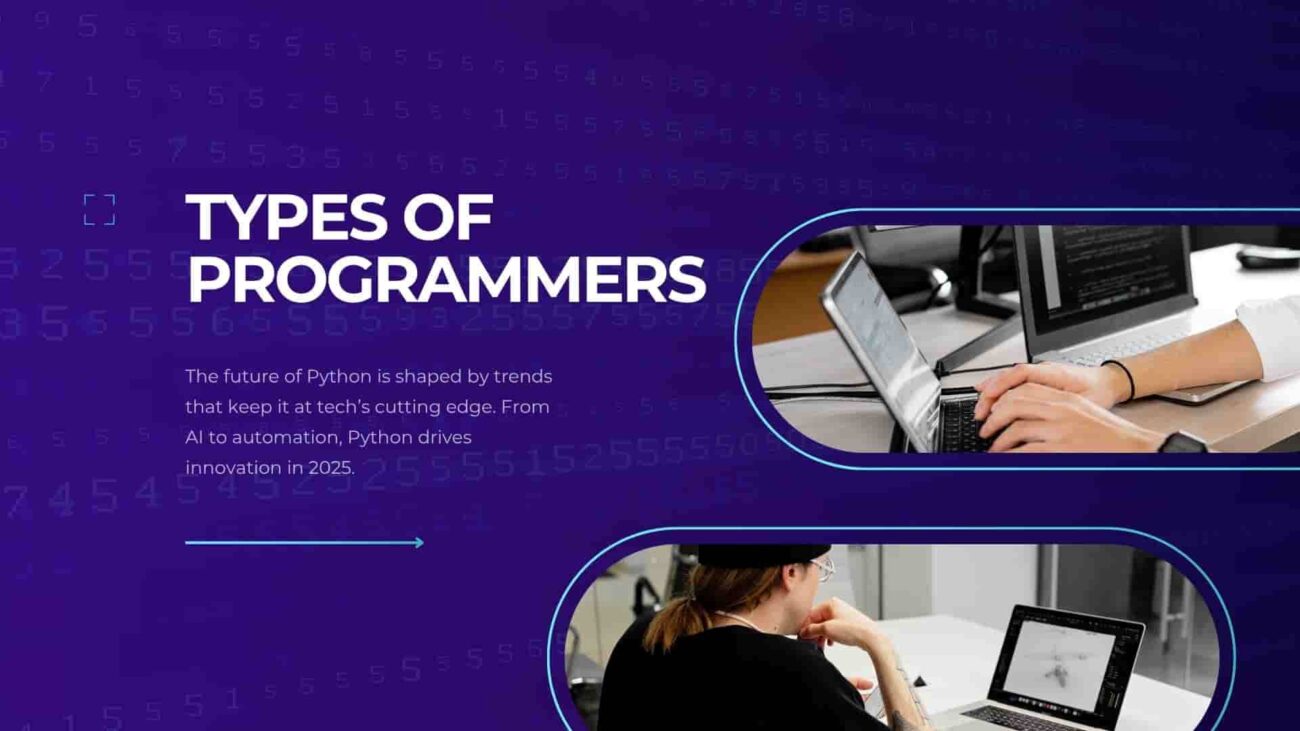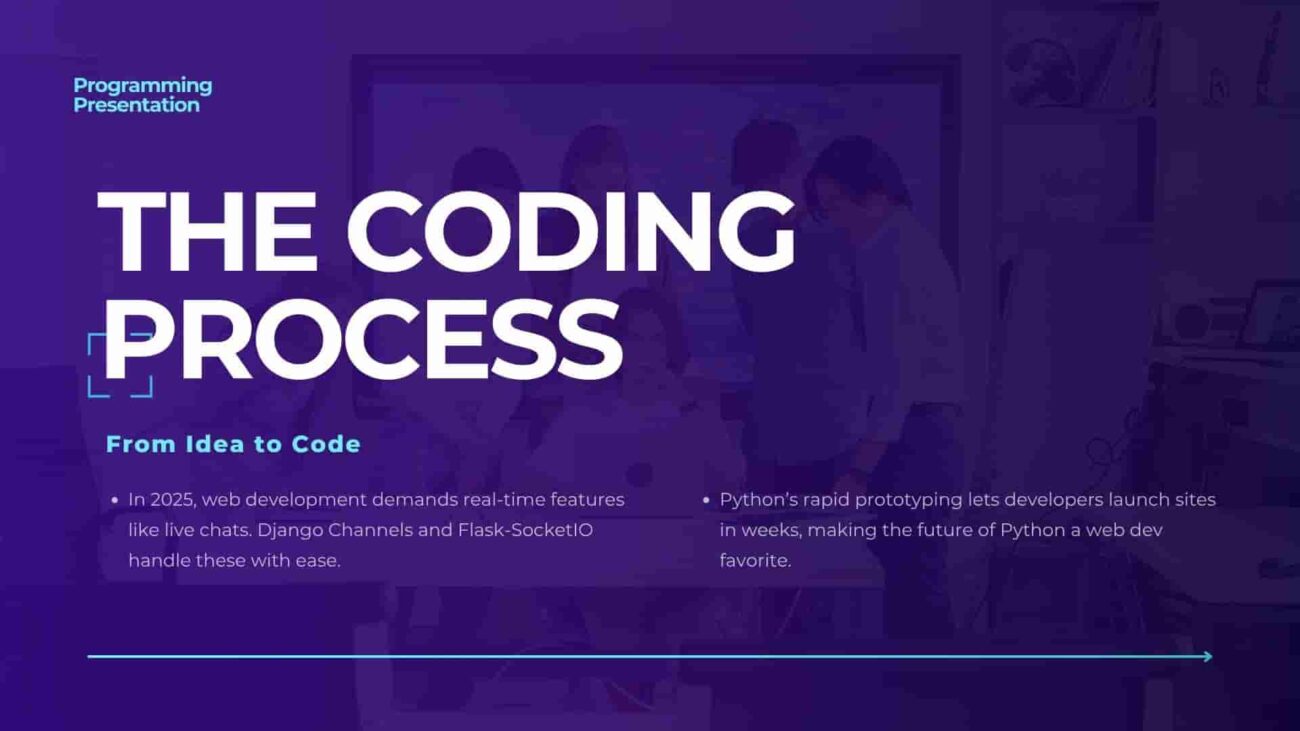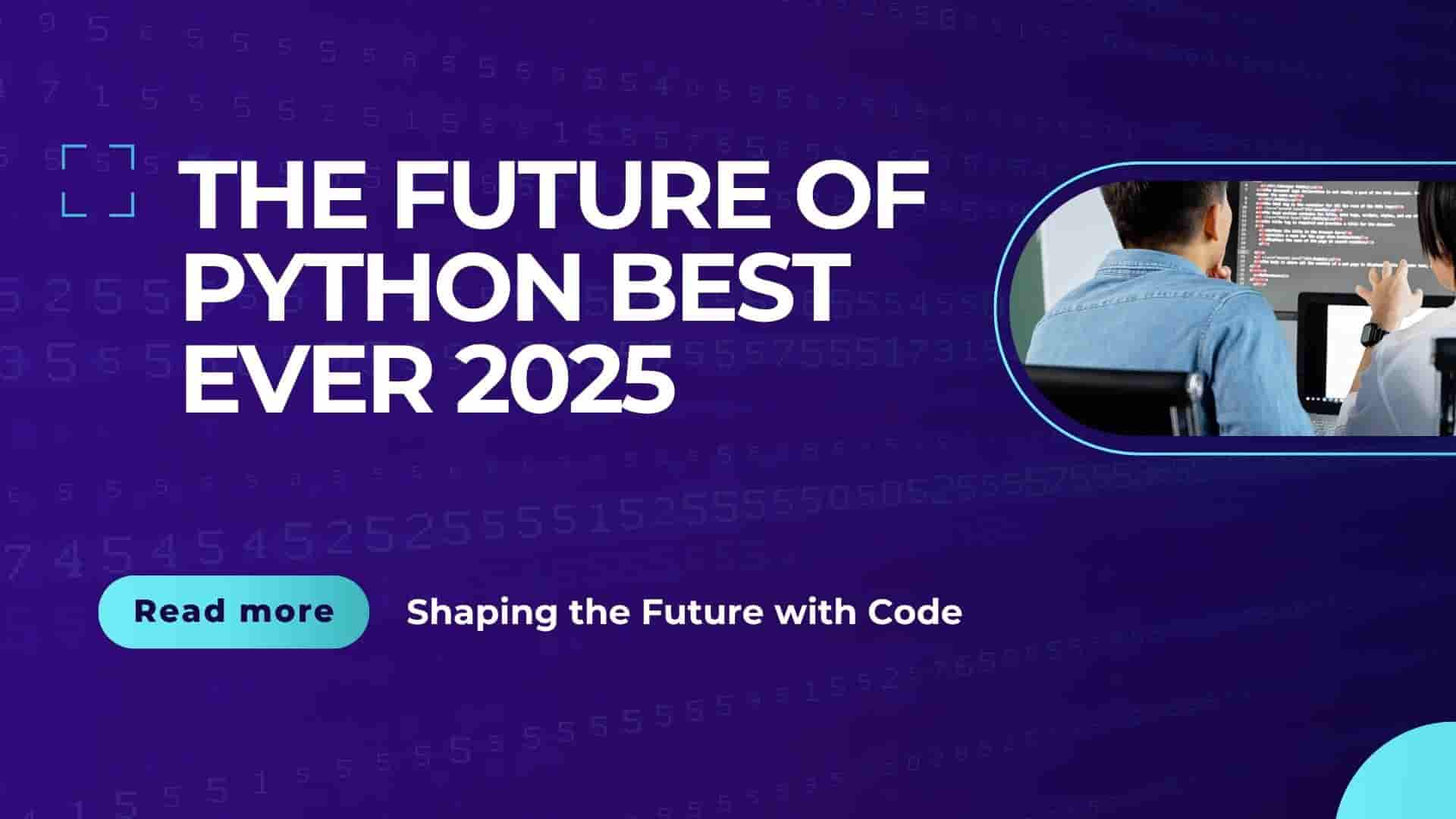Why Python Rules in 2025
In 2025, Python isn’t just surviving—it’s ruling the coding world like a benevolent monarch. Its blend of simplicity, power, and adaptability makes it the go-to language for beginners and tech giants alike. The future of Python is rock-solid, thanks to its ability to evolve with technology. Let’s break down why Python reigns supreme.
Python’s Easy-to-Read Syntax
Picture a language that feels like writing a to-do list. That’s Python. Its syntax is so clear, it’s practically poetry. For example, to print “Hello, World!” you just write: print("Hello, World!"). No cryptic symbols or endless semicolons. This simplicity makes Python a dream for beginners, reducing the learning curve to a gentle slope.
For seasoned developers, Python’s readability means faster coding. Less time wrestling with syntax leaves more for solving real problems. In 2025, this efficiency powers startups and enterprises, from Silicon Valley to global tech hubs. The future of Python thrives on its accessibility, inviting everyone to code.
Scalability and Performance
Critics once called Python slow, but in 2025, that’s ancient history. Tools like PyPy (a faster interpreter) and Cython (which compiles Python to C) boost performance. Python powers YouTube, handling billions of views daily, proving it scales like a champ.
In cloud environments, Python integrates with AWS and Google Cloud, managing massive workloads. For example, Dropbox uses Python for its backend, syncing files globally. The future of Python is fast, scalable, and ready for enterprise demands.
Future of Python Trends
The future of Python is shaped by trends that keep it at tech’s cutting edge. From AI to automation, Python drives innovation in 2025. Let’s explore the trends fueling its rise.

AI and Machine Learning Dominance
Python is the heart of AI, and in 2025, it’s beating stronger than ever. Libraries like TensorFlow, PyTorch, and Scikit-learn simplify complex algorithms. From chatbots (like me, Grok!) to self-driving cars, Python powers intelligent systems across industries.
Why Python for AI? Its libraries handle heavy math, and pre-built models save time. For instance, TensorFlow lets you train a neural network with minimal code. In healthcare, Python models predict disease outbreaks; in finance, they detect fraud. The future of Python in AI is transformative.
Web Development Surge
Python’s web frameworks, Django and Flask, shine in 2025. Django’s “batteries-included” approach offers security and scalability, powering sites like Pinterest and Mozilla. Flask, lightweight and flexible, suits startups building MVPs (minimum viable products).
In 2025, web development demands real-time features like live chats. Django Channels and Flask-SocketIO handle these with ease. Python’s rapid prototyping lets developers launch sites in weeks, making the future of Python a web dev favorite.
Security is another win. Django’s built-in protections against SQL injection and XSS attacks keep sites safe. The future of Python in web development is secure and innovative.
Data Science and Analytics Powerhouse
Data is king, and Python is its trusted advisor. Libraries like Pandas, NumPy, and Matplotlib turn raw data into insights. In 2025, businesses use Python to predict trends, from stock prices to customer preferences.
Pandas processes millions of data rows in seconds, while Matplotlib creates charts that make CEOs swoon. For example, a retailer might use Python to analyze sales data and optimize inventory. The future of Python in data science is data-driven decision-making.
Automation and Scripting Revolution
Python automates the boring stuff, saving time and sanity. In 2025, businesses use Python to streamline tasks like email campaigns or server management.
Explore Python’s AI capabilities at TensorFlow’s official site.
Python for Every Age
Python’s superpower is its universal appeal. From kids to seniors, the future of Python welcomes all. Let’s see how Python fits every age group in 2025.
Kids and Teens: Coding as Play
Python is a playground for young coders. Its simple syntax lets kids focus on creativity, not confusion. Libraries like Pygame turn coding into game design, while platforms like CodeCombat gamify learning.
A 12-year-old can code a platformer game in Pygame, learning loops and logic while having fun. Schools in 2025 teach Python in STEM programs, preparing kids for tech careers. The future of Python starts young.
Parents, relax—Python is safe and accessible. Free platforms like Trinket offer guided lessons, and communities like Raspberry Pi provide kid-friendly projects. Python’s fun factor makes it a hit with teens.
Adults: Career Changers’ Ally
In your 30s or 40s and craving a career pivot? Python’s your golden ticket. Its demand in AI, data science, and web development means high-paying jobs. Bootcamps like General Assembly teach Python in months, turning marketers or teachers into developers.
Python’s readability lowers the entry barrier. A nurse can learn to analyze patient data with Pandas; a writer can build a blog with Flask. The future of Python empowers adults to leap into tech.
Seniors: Lifelong Learning
Retirement is no time to stop learning. In 2025, seniors use Python for hobbies like home automation or stock analysis. Online courses on Coursera or edX fit flexible schedules, and Python’s clear syntax suits older learners.
A retiree might code a script to monitor investments or automate smart home devices. The future of Python keeps minds sharp, proving coding is ageless.
Want to inspire young coders? Check our coding for kids guide.
How to Learn Python Fast
Learning Python is like baking a cake—follow the recipe, and you’ll get results. In 2025, resources abound to make you a Python pro. Here’s your guide to mastering the future of Python.
Free Online Courses
Platforms like Codecademy, Coursera, and edX offer free or low-cost Python courses. Codecademy’s interactive Python 3 course covers basics in hours, from variables to functions. Coursera’s university-backed courses dive into AI and data science.
Start with Codecademy for hands-on practice, then try Coursera’s “Python for Everybody” for deeper insights. These platforms use quizzes and projects, making learning fun and effective. The future of Python education is interactive.
Books and Tutorials
Books like “Automate the Boring Stuff with Python” by Al Sweigart teach practical skills with humor. “Python Crash Course” by Eric Matthes covers basics to advanced topics like data analysis. Both are beginner-friendly.
YouTube is a goldmine. Channels like Corey Schafer and Tech With Tim break down topics like web scraping or OOP with clear examples. The future of Python learning is visual and engaging.
Practice with Projects
Projects are where Python shines. Build a to-do list app, a weather scraper, or a chatbot. These hands-on tasks cement skills and impress employers. GitHub lets you showcase projects, boosting your portfolio.
Start small: a script that emails daily news. Then tackle complex projects, like a machine learning model to predict stock trends. The future of Python rewards consistent practice.
Sites like HackerRank and LeetCode offer coding challenges to sharpen skills. Join a 100-day coding challenge to stay motivated and track progress.
Community Support
Python’s community is your cheerleader. Join Reddit’s r/learnpython or Stack Overflow to ask questions. Discord servers like Python Hub offer real-time help. The future of Python thrives on collaboration..
Top Python Learning Platforms
| Platform | Cost | Best For | Key Feature |
|---|---|---|---|
| Codecademy | Free/Paid | Beginners | Interactive coding |
| Coursera | Free/Paid | Advanced learners | University courses |
| Udemy | Paid | Project-based | Video tutorials |
| edX | Free/Paid | Academics | Certification |
| FreeCodeCamp | Free | Self-paced | Real-world projects |
Python Career Paths in 2025
The future of Python is a job seeker’s paradise. Python skills unlock high-paying, flexible careers. Here are the top roles in 2025.
Python Developer
Python developers build apps, websites, and tools using frameworks like Django and Flask. In 2025, U.S. salaries range from $90K to $120K, with remote work common. Companies like Amazon hire Python devs for scalable systems.
Skills needed: Python, Django/Flask, Git, and basic front-end (HTML/CSS). Build a portfolio with projects like a blog or e-commerce site to stand out.
Data Scientist
Data scientists use Python to uncover insights from data. Libraries like Pandas and Scikit-learn analyze trends, from customer behavior to climate patterns. Salaries range from $100K to $150K, with demand in finance and healthcare.
For example, a data scientist might use Python to predict sales trends, helping retailers optimize stock. The future of Python in data science is booming.
AI Engineer
AI engineers build smart systems, from chatbots to recommendation engines. Python’s TensorFlow and PyTorch simplify AI development. Salaries often exceed $120K, with growth in 2025.
An AI engineer might code a model to detect spam emails or power a virtual assistant. The future of Python in AI is a high-reward field.
DevOps Engineer
DevOps engineers automate cloud infrastructure with Python. Tools like Ansible and Docker integrate with Python scripts for seamless deployments. Salaries range from $95K to $130K, with tech hubs hiring aggressively.
Python scripts automate server tasks, like scaling AWS instances. The future of Python in DevOps is about efficiency and scale.

Perks of Python Careers
- High salaries: Earn $90K–$150K in top roles.
- Remote work: Flexibility to work from anywhere.
- Variety: Choose AI, web, data, or automation.
- Growth: Constant learning in cutting-edge fields.
- Impact: Build tools that shape industries.
Top Python Tools & Libraries
Python’s ecosystem is a treasure chest of tools and libraries, making coding faster and fun. The future of Python is powered by these gems.
Popular IDEs
PyCharm and VS Code are coder favorites. PyCharm offers robust debugging and refactoring, ideal for pros. VS Code, free and lightweight, supports Python plugins, making it a 2025 staple. Both provide auto-completion, saving time.
VS Code’s popularity soars for its open-source nature, while PyCharm’s professional version suits enterprise teams. The future of Python coding is smooth with these IDEs.
Essential Libraries
Python’s libraries are its magic wand. Key players in 2025 include:
- NumPy: Fast numerical computations for science.
- Pandas: Data manipulation for analytics.
- Requests: Easy API interactions.
- BeautifulSoup: Web scraping simplified.
- Matplotlib: Stunning visualizations.
These libraries save hours, letting you focus on creativity. The future of Python is rich with tools for every task.
Automation Tools
Python excels in automation. PyAutoGUI controls keyboards and mice, while Selenium automates browsers for testing. Businesses use these to streamline workflows, from QA to IT management, ensuring the future of Python in automation is bright.
Challenges in Python’s Future
Even kings face challenges, and the future of Python isn’t without hurdles. Let’s explore these and how Python overcomes them in 2025.
Performance Myths
Python’s interpreted nature can be slower than compiled languages like C++. But tools like PyPy and Cython optimize speed. In 2025, Python handles large-scale apps, from cloud systems to AI models, debunking performance myths.
For example, PyPy’s just-in-time compilation makes Python scripts run faster. The future of Python is performance-ready for enterprise needs.
Competition from New Languages
Rust and Go are rising stars, excelling in systems programming and concurrency. Yet, Python’s vast ecosystem and community keep it ahead. Its ease and versatility ensure the future of Python remains dominant.
Python’s libraries outnumber competitors, offering solutions for every niche. This depth makes Python hard to dethrone.
Mobile Development Gaps
Python lags in mobile app development, where Java and Swift lead. However, frameworks like Kivy and BeeWare are closing this gap, enabling Python apps on iOS and Android. The future of Python is expanding into mobile.
Python’s Global Community
The future of Python thrives on its passionate community. From forums to conferences, Pythonistas support each other worldwide.
Online Forums
Stack Overflow, Reddit’s r/python, and Python Discord are buzzing with help. Beginners ask about loops; pros share AI tips. These platforms ensure the future of Python is collaborative and inclusive.
Post a question on r/learnpython, and you’ll get answers in hours. This accessibility makes Python welcoming for all.
Conferences and Meetups
PyCon 2025, held globally, offers workshops and talks. Local meetups connect coders for hackathons and learning. These events foster innovation, driving the future of Python.
Virtual PyCon sessions make learning accessible, while in-person events build networks. Python’s community is its heartbeat.
Open-Source Power
Python’s open-source nature invites contributions. In 2025, thousands enhance libraries on GitHub, keeping Python cutting-edge. From Pandas to TensorFlow, community efforts shape the future of Python.
Fun Python Projects to Try
Projects make Python learning fun and practical. In 2025, hands-on coding builds skills and portfolios. Here are projects to spark your future of Python journey.
Build a Chatbot
Create a chatbot with Python’s NLTK or ChatterBot. Teach it to answer questions or tell jokes. This project introduces AI and natural language processing, key to the future of Python.
Start with a simple bot that responds to greetings. Add complexity, like fetching weather data via APIs. Share it on GitHub to impress employers.
Code a Game with Pygame
Pygame lets you build games like Snake or Space Invaders. Kids and teens love this, but adults enjoy it too. Coding games teaches logic and creativity, boosting the future of Python.
A basic game might use Pygame to move a sprite with arrow keys. Add features like scoring or levels to challenge yourself.
Automate Tasks
Use Python to automate chores, like renaming files or sending emails. Libraries like PyAutoGUI and smtplib make this easy. Automation projects showcase Python’s practical power.
For example, write a script to download daily news articles or organize photos. These projects save time and highlight the future of Python in automation.
Data Visualization Dashboard
Create a dashboard with Plotly or Seaborn to visualize data, like stock prices or weather trends. This project teaches data science skills, central to the future of Python.
Start with a CSV file and plot a graph. Add interactivity, like filters, to make it professional. Share it online to boost your resume.
What Lies Ahead for Python
The future of Python is a thrilling horizon. In 2025, Python evolves with faster interpreters, like Python 3.12, and new libraries for quantum computing and IoT. Its role in education grows, with more schools adopting Python for STEM.
Python’s community drives innovation, with open-source projects tackling AI ethics and sustainability. Frameworks like FastAPI gain traction for high-performance APIs, while Python’s mobile presence grows with Kivy.
As tech advances, Python adapts, ensuring its reign continues. The future of Python is about accessibility, innovation, and community, making it a language for generations.
Conclusion
In 2025, the future of Python shines like a beacon in tech’s galaxy. Its simplicity, versatility, and vibrant community make it the ultimate coding language for all ages. From powering AI breakthroughs to automating daily tasks, Python drives innovation in web development, data science, and beyond. Kids code games, adults pivot careers, and seniors explore hobbies—all with Python’s friendly syntax. Trends like AI and automation, paired with tools like PyCharm and Pandas, ensure Python’s dominance.
Read more: AI Tools That Will Revolutionize Your Work Best of 2025
Python FAQs
1. Is Python still relevant in 2025?
Yes! Python’s dominance in AI, data science, and web development keeps it vital. Its simplicity and community ensure the future of Python is robust, with high demand in tech jobs.
2. Can kids learn Python easily?
Absolutely! Python’s clear syntax and fun projects like Pygame games engage kids. Platforms like CodeCombat make learning interactive, shaping the future of Python for young coders.
3. How does Python power AI?
Python drives AI with libraries like TensorFlow and PyTorch, simplifying complex algorithms. From chatbots to neural networks, the future of Python in AI transforms healthcare, finance, and more.
4. How long to learn Python?
Basics take 2–3 months with daily practice. Mastery depends on projects, but free courses and tutorials accelerate learning, paving the way for the future of Python skills.
5. Are Python jobs well-paid?
Yes! Python developers, data scientists, and AI engineers earn $90K–$150K in 2025. The future of Python offers lucrative, flexible careers in high-demand tech fields.

